| 主要功能 | |||||
| 1. 专业分析浮游植物细胞,同时具备传统流式细胞仪经典功能 | 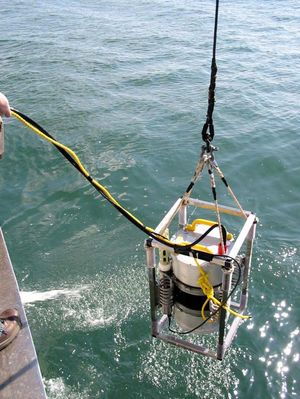 | ||||
| 2. 可以扫描记录各种光学信号(散射、荧光)的动态变化 | |||||
| 3. 可实现高频、原位分析水体微生物群落及优势种变化 | |||||
| 4. 可在完整的藻类粒径谱范围内对生物量进行线性评估 | |||||
| 5. 可直接分析大尺寸范围的浮游藻类、团体结构,可现场分析微囊藻群体结构变化 | |||||
| 6. 可调式PMT可根据检测粒径大小调节检测器灵敏度 | |||||
| 7. 流动成像技术可对感兴趣感兴趣的聚群进行圈门设定后专门拍照 | |||||
| 8. 脉冲信号指纹图谱技术,圈门直观方便,更真实反应细胞形态 | |||||
| 9. 水下测量(CytoSub)可在整个真光层分析浮游植物动态 | |||||
| 10. 可整合入浮标中或其它载体上进行在线监测,可配合CTD对水体做剖面测量 | |||||
| 11.实现实验室远程控制基站式自动在线监测,可实现完全自动检测,无人值守在线监测 | |||||
| 测量参数 | |||||
| 光学参数: 前向散射FWS、侧向散射SWS,荧光散射FLR、 FLY、 FLO | |||||
| 形态参数: 能同时获得包括细胞和颗粒形态物理特性(数量、长度、大小、形态、粒度、色素、峰数等)、群体特征、脉冲图谱等在内的9个拓扑学指标及最少45组参数 | |||||
| JD计数:自然水体总颗粒计数,圈门后可集群计数及浓度计算,可实现链状藻单细胞数计数功能 | |||||
| 其他测量参数:分析体积、进样速率等 | |||||
| 应用领域 | |||||
| 1. 海洋生态学与淡水生态学 | |||||
| 2. 流域监测与管理 | |||||
| 3. 海洋学与湖沼学 | |||||
| 4. 有害藻华(HABs)预警 | |||||
| 5. 微藻生物技术 | |||||
| 6. 河流、水库、湖泊、海洋的监测与管理 | |||||
| 7. 监测与管理 | |||||
| 8. 水源地、水厂、污水处理厂的水质监测 | |||||
| 9. 富营养化研究 | |||||
| 10. 藻类环境生物学 | |||||
| 11. 水产养殖 | |||||
| 选购指南: | |||||
| 一、便携式浮游植物流式细胞仪CytoSense | |||||
| 系统组成: | |||||
| 流式细胞仪分析主机:相干高质量连续固态激光器,标配波长488nm, 可选波长445nm、635nm、640nm、660nm等,最多可配置7个检测器(检测通道含FWS L+R、SWS、YF、RF、OF)。 | |||||
| 野外便携式外壳:仪器采用碳素纤维外壳,防溅水设计,更轻便(<15kg),整机安装于轻质铝质框,带高质量防震垫。包装于便携式航空箱内。 | |||||
| 数据分析系统:含便携式笔记本电脑,预装数据采集软件CytoUSB,和数据分析软件CytoClus | |||||
| 批量处理数据分析软件EasyClus : 需购买MatLab软件配合使用 | |||||
| 高速流动成像模块:可选。 | |||||
|  | 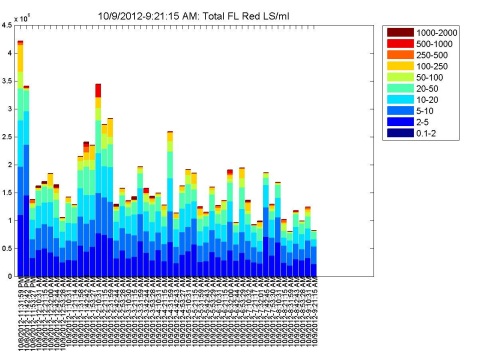 | |||
| 便携式浮游植物流式细胞仪 | Easyclus 粒径分布图 | Easyclus 散点图 | |||
| 系统组成: | |||||
| 主机:浅水版Cytosub (水下20米),含CytoSense所有基本配置 | |||||
| 浮标模块:包括浮标、太阳能电池板、充电电池、浮标灯、电子系统、无线传输装置和采样管防水连接器等。根据用户需要,也可扩展为易拆卸浮标模块,这样用户可以非常方便的在CytoSense(室内用)和CytoBuoy(在线监测)间转换。 | |||||
| 注意:野外在线监测时不仅仅限于以浮标作为平台,其他平台也可,只要可以具备放置CytoSense的空间及供电即可。同时,增加Bacterial staining module,可实现水体异养微生物自动染色和在线分析,可在线检测藻类、细菌、浮游动物及沉积物等颗粒。具体信息请来电咨询。 | |||||
| |||||
| CytoBuoy 浮体 | |||||
| CytoBuoy通讯模式:无线通讯 | |||||
| |||||
| 三、水下浮游植物流式细胞仪——CytoSub | |||||
| 主机:台式机CytoSense是防溅水设计,可以在野外使用,但不能水下使用。CytoSense加上一个水下模块(SUB MODULE)就组成了水下式流式细胞仪CytoSub。 | |||||
| 水下模块:一个耐受200 m水深压力的防水外壳,阀门和进样环路部分(包括循环泵),电子控制单元,数采,水下连接器和支架。 | |||||
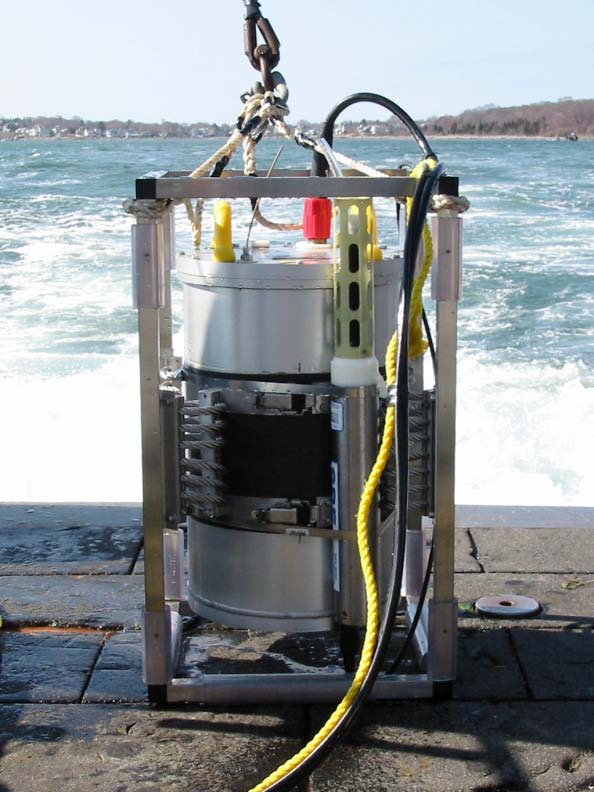 | 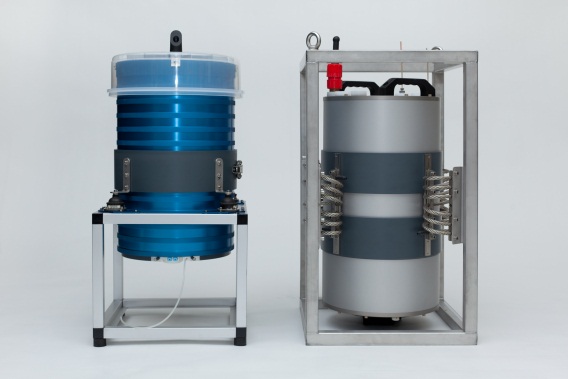 | ||||
| Cytosub 主机 | CytoSense 与CytoSub 转换 | ||||
| 工作模式一:AUV搭载 | |||||
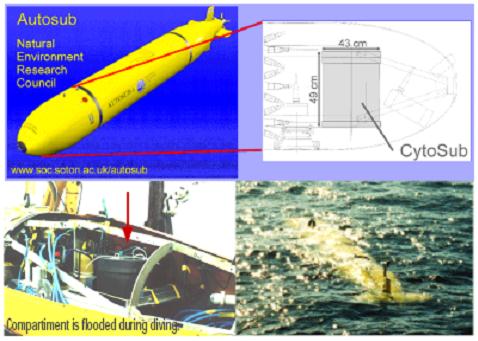 | |||||
| 利用英国国家海洋中心AutoSub型AUV搭载CytoSub | |||||
| 工作模式二:水下垂直剖面分析 | |||||
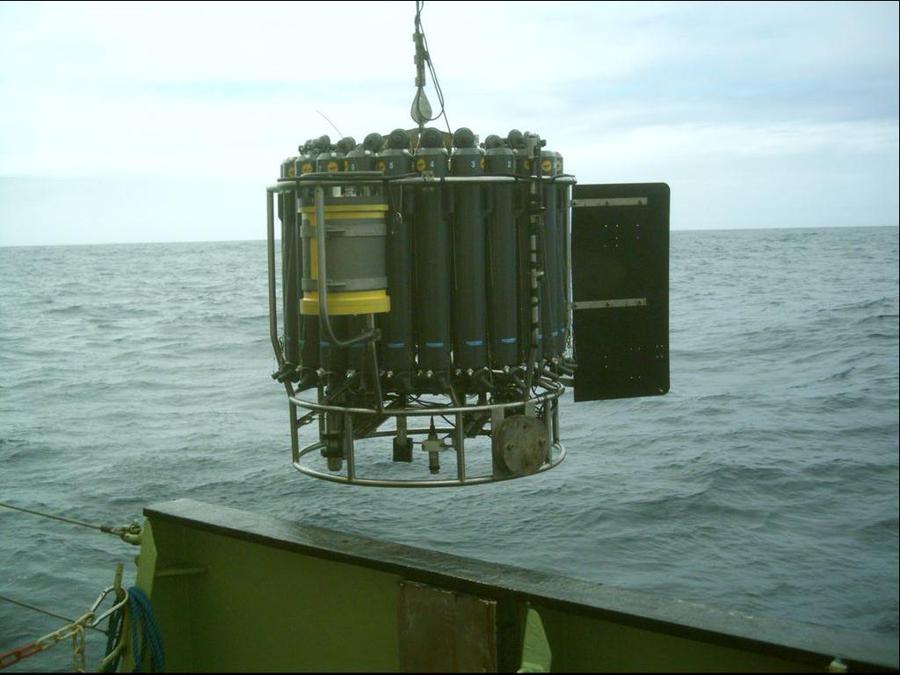 | |||||
| 与CTD结合一起测量 | |||||
| 注意:此外,水下型浮游植物流式细胞仪CytoSub可应用于浮标,Ferrybox等监测平台,在垂直剖面不同层位获取浮游植物生物量信息,对研究微囊藻沉浮机制,浮游动物、水文、水质等因素对浮游植物生态位影响提供数据依据。 | |||||
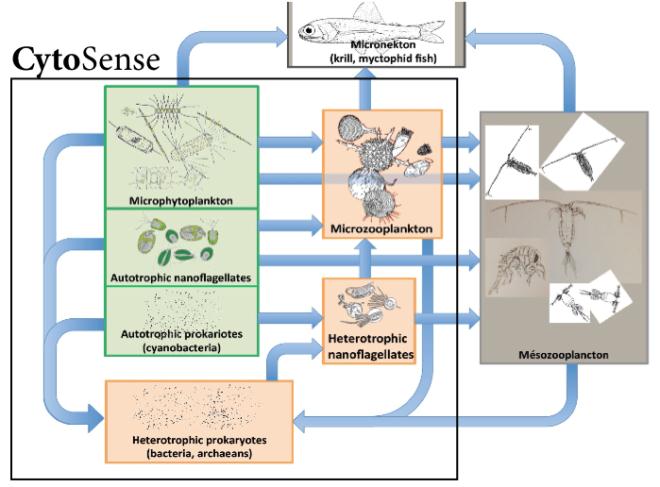 | 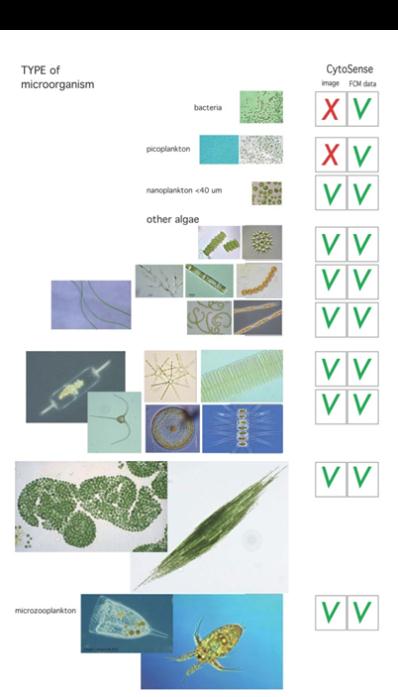 | ||||
| CytoSense 检测对象 | |||||
| 产地:荷兰 CytoBuoy | |||||
| 参考文献 |
| 数据来源: Cytometry , Goolge scholar等,截至2016年,共收集相关文献近100篇。 |
1. Simon Bonato a, Elsa Breton , al e: Spatio-temporal patterns in phytoplankton assemblages ininshore–offshore gradients using flow cytometry: A case study in the eastern English Channel, Journal of Marine Systems 2016,76-83.[CytoSense] 2. Goran Bakalar & Vinko Tomas, Possibility of Using Flow Cytometry in the Treated Ballast Water Quality Detection, Pomorski zbornik 51 (2016), 43-55 3. Quan Zhou, Wei Chen, al e: A flow cytometer based protocol for quantitative analysis of bloom-forming cyanobacteria (Microcystis) in lake sediments, Journal of Environmental Sciences 2012, 24(9) 1709–1716 4. A. Mansour, I. Leblond al.e: Invited Paper: Wireless Sensor Networks for Ecosystem Monitoring & Port Surveillance. (WSCN 2013) 5. Endymion D. Cooper , Bastian Bentlage al e: Metatranscriptome profiling of a harmful algal bloom.Harmful Algea 37(2014)75-83. 6. SERGIO A. COELHO-SOUZA, FÁBIO V. ARAÚJO al e: Bacterial and Archaeal Communities Variability Associated with Upwelling and Anthropogenic Pressures in the Protection Area of Arraial do Cabo (Cabo Frio region - RJ). Anais da Academia Brasileira de Ciências (2015) 87(3):1737-1750 7. Malkassian, A., D. Nerini, al. e: Functional analysis and classification of phytoplankton based on data from an automated flow cytometer. Cytometry Part A 2011, 94A:263-275. [Cytosense] 8. Thyssen, M., B. Beker, al. e: Phytoplankton distribution during two contrasted summers in a Mediterranean harbour: combining automated submersible flow cytometry with conventional techniques. Environmental Monitoring and Assessment 2011, 173:1-16. 9. Thyssen, M., Denis M: Temporal and Spatial High-Frequency Monitoring of Phytoplankton by Automated Flow Cytometry and Pulse-Shape Analysis. Springer Netherlands 2011:293-298. 10. Vidoudez, C., J. C. Nejstgaard, al. e: Dynamics of Dissolved and Particulate Polyunsaturated Aldehydes in Mesocosms Inoculated with Different Densities of the Diatom Skeletonema marinoi. Marine Drugs 2011, 9: 345-358. 11. Hansen, B. W., H. H. Jakobsen, al. e: Swimming behavior and prey retention of the polychaete larvae Polydora ciliata. Journal of Experimental Biology 2010:3237-3246. 12. Pereira GC, Figuiredo ARd, Jabor PM, Ebecken1 NFF: Assessing the ecological status of plankton in Anjos Bay: a flowcytometry approach. Biogeosciences Discuss 2010, 7:6243–6264. [cytobuoy] 13. Barofsky, A., Simonelli P, al e: Growth phase of the diatom Skeletonema marinoi influences the metabolic profile of the cells and the selective feeding of the copepod Calanus spp. J Plankton Res 2009, 32:263-272. [CytoBuoy] 14. Donk V, E., Cerbin S, al e: The effect of a mixotrophic chrysophyte on toxic and colony-forming cyanobacteria. Freshwater Biology 2009, 54:1843-1855. 15. Pereira, C. G, Granato A, al. e: Virioplankton Abundance in Trophic Gradients of an Upwelling Field. Brazilian Journal of Microbiology 2009, 40:857-865. [CytoBuoy] 16. Thyssen, M., Mathieu D, al. e: Short-term variation of phytoplankton assemblages in Mediterranean coastal waters recorded with an automated submerged flow cytometer. J Plankton Res 2008, 30:1027-1040. [Cytosub] 17. Thyssen, T. M, Garcia N, al. e: Sub meso scale phytoplankton distribution in the north east Atlantic surface waters determined with an automated flow cytometer. Biogeosciences Discuss 2008, 5:2471-2503. [Cytosub] 18. Dubelaar, J. GB, Casotti R, al. e: Phytoplankton and their analysis by flow cytometry. Flow Cytometry with Plant Cells 2007:287-322. [CytoBuoy] 19. Takabayashi, M., Lew K, al e: The effect of nutrient availability and temperature on chain length of the diatom, Skeletonema costatum. J Plankton Res 2006, 28:831-840. [CytoSense] 20. Takabayashi, M., Wilkerson FP, al. e: Response Of Glutamine Synthetase Gene Transcription And Enzyme Activity To External Nitrogen Sources In The Diatom Skeletonema Costatum (Bacillariophyceae). J Phycol 2005, 41:84-94. [Cytobuoy] 21. Dubelaar, J. GB, Geerders PJF: Innovative technologies to monitor plankton dynamics. Sea Technol 2004, 45:15-21. [CytoSub] 22. Dubelaar, J. GB, Geerders PJF, al. e: High frequency monitoring reveals phytoplankton dynamics. J Environ Monit 2004, 6:946-952. [Cytosense] 23 Cunninghama, A., McKeea D, al e: Fine-scale variability in phytoplankton community structure and inherent optical properties measured from an autonomous underwater vehicle. J Mar Syst 2003, 43:51-59. 24. Dubelaar, J. GB, Gerritzen PL: CytoBuoy: a step forward towards using flow cytometry in operational oceanography. Sci Mar (Barc) 2000, 64:255-265. [CytoBuoy] 25. Dubelaar, J. GB, Jonker RR: Flow cytometry as a tool for the study of phytoplankton. Scientia Marina 2000, 64. [CytoBuoy] 26. Jonker R, Droben R, Tarran G, Medlin L, Wilkins M, Garcla L, zabala L, boddy l: Automated identification and characterisation of microbial populations using flow cytometry: the AIMS project. scientia marina 2000, 64:225-234. [Cyto] 27. Woodd-Walker, S. R, Gallienne CP, al e: A test model for optical plankton counter (OPC) coincidence and a comparison of OPC-derived and conventional measures of plankton abundance. J Plankton Res 2000, 22:473-483. 28. Dubelaar, J. GB, Gerritzen PL, al e: Design and first results of CytoBuoy: A wireless flow cytometer for in situ analysis of marine and fresh waters. Cytometry 1999, 37:247-254. [CytoBuoy] 29. Wilkins, F. M, Boddy L, al e: Identification of Phytoplankton from Flow Cytometry Data by Using Radial Basis Function Neural Networks." Appl Environ Microbiol 1999, 65:4404-4410. 30. Jonker, R. R, Meulemans JT, al e: Flow cytometry: A powerful tool in analysis of biomass distributions in phytoplankton. Water SciTechnol 1995, 32:177-182. [Cytosense] 31. Jonker, R. R, G. B. J. Dubelaar, al. e: The European Optical Plankton Analyser: A high dynamic range flow cytometer. Scientia Marina 1994. 32. Dubelaar, G. B. J., A. Groenewegen ea: Optical plankton analyser: a flow cytometer for plankton analysis, II: Specifications. Cytometry 1989, 10:529-539. [OPA] 33. Peeters, J. C. H., G. B. J. Dubelaar, al e: Optical plankton analyser: A flow cytometer for plankton analysis, I: Design considerations. Cytometry 1989, 10:522-528. [OPA] |
上海泽泉科技股份有限公司
仪器网(yiqi.com)--仪器行业网络宣传传媒